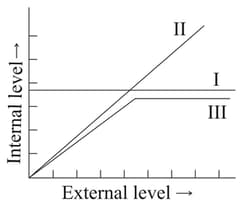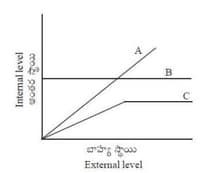EASY
Earn 100
A butterfly of India when resting with folded wings resembles a dead leaf. What is this mechanism of protection called?
(a)Hiding.
(b)Mimicry.
(c)Congregation.
(d)Camouflage.
50% studentsanswered this correctly
Important Questions on Organisms and Populations
HARD
EASY
EASY
Observe the following graph of regulators

In the above graph I, II and III represent
HARD
EASY
EASY
MEDIUM
Reason : Brackish water animals can withstand wide fluctuations in salinity
EASY
MEDIUM
EASY
MEDIUM
Match List with List.
| List | List | ||
| (a) | Allen's Rule | (i) | Kangaroo rat |
| (b) | Physiological adaptation | (ii) | Desert lizard |
| (c) | Behavioural adaptation | (iii) | Marine fish at depth |
| (d) | Biochemical adaptation | (iv) | Polar seal |
EASY
HARD
Reason (R): Due to low atmospheric pressure at high altitude, the body does not get sufficient oxygen.
In the light of the above statements, choose the correct answer from the options given below.
EASY
MEDIUM
Which of the following statements are wrong regarding biodiversity ?
(i) Tropics harbor more species than temperate or polar areas
(ii) Terrestrial biodirersity increases from the equator to the poles
(iii) Patterm of biodiversity should not depend on latitude and species area relationship
(iv) Biodiversity exists not only at the species level but also at the lerels of biological organization
(v) Temperate regions are relatively more constant than that of the tropical regions
EASY
(i) Pond is an ideal example to understand the fundamentals of the aquatic ecosystem.
(ii) In deep lakes, light can penetrate more than 200m in depth.
(iii) Deep water lakes contain three distinct zones namely the littoral zone, limnetic zone, profundal zone.
(iv) Littoral zone is the shallow part of the lake closer to the shore.
(v) Limnetic zone is the open water zone away from the shore.
(vi) The rate of photosynthesis is equal to the rate of respiration in the littoral zone.
MEDIUM
I. Amoeba has contractile vacuole.
II. Glomerular kidneys in freshwater fishes.
III. Sponges form gemmules.
IV. Neoceratodus forms a gelatinous cocoon.
Among the above, the correct statements are
EASY
With reference to temperature adaptations, identify of the following graph

EASY
MEDIUM

